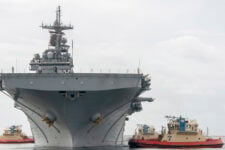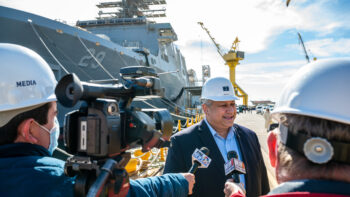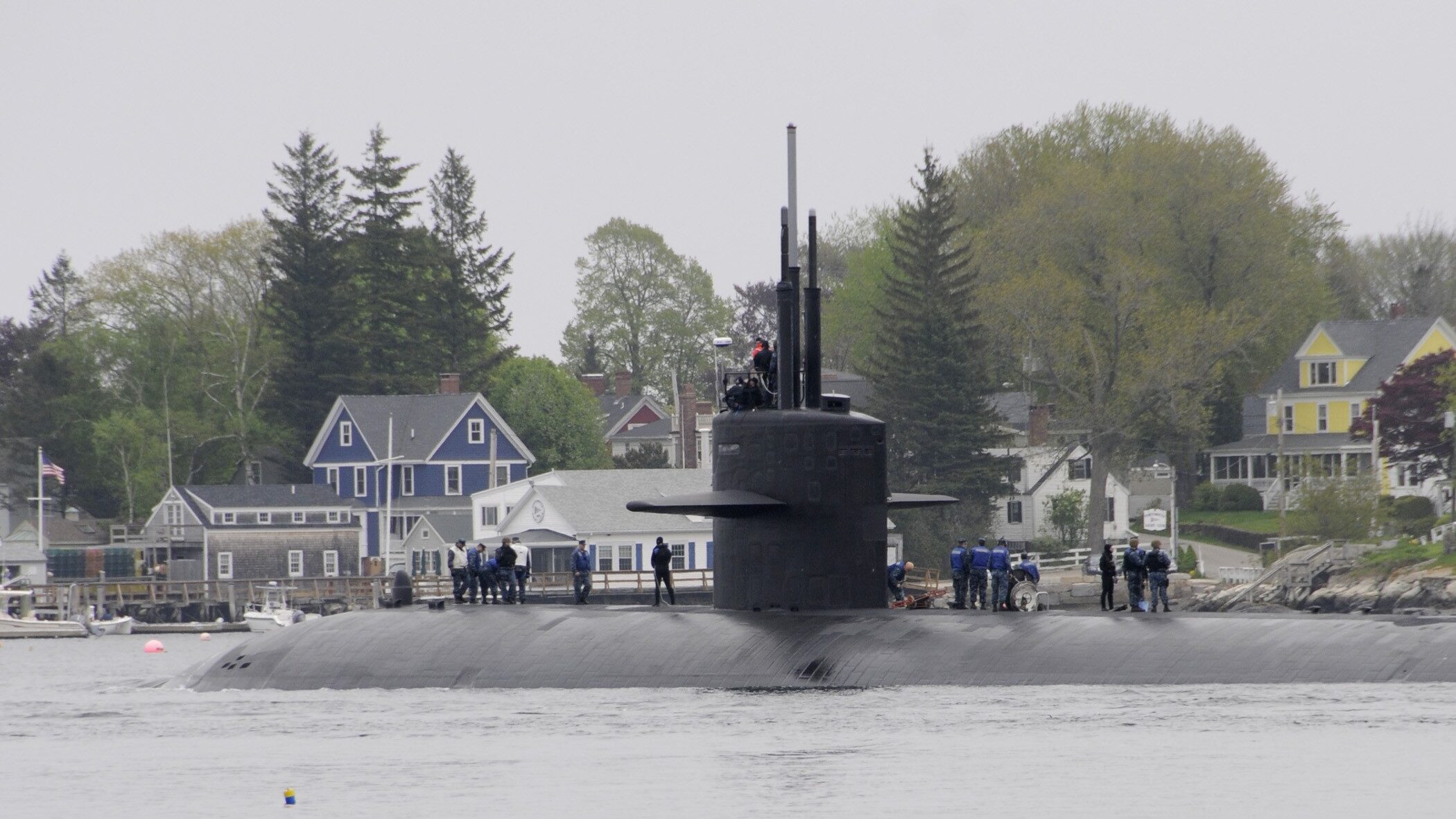
The Los Angeles-class attack submarine Helena (SSN-725) departs Portsmouth Naval Shipyard after completion of extended maintenance. (U.S. Navy photo by James Cleveland)
This report was updated 5/9/2022 at 11:43 a.m. ET to clarify the status of Bartlett’s second submission to the Navy.
WASHINGTON: It was an uncomfortable, although not wholly surprising, admission by one of the Navy’s most senior officers. In a January speech, the head of US Fleet Forces made it clear that if the US got into a naval war, there was no way the service could keep damaged ships in the fight.
“If I went into conflict, high-end conflict where I had to repair numerous ships simultaneously, I don’t have enough capacity. I don’t have enough dry docks, and I don’t have enough shipyards to get after that,” Adm. Daryl Caudle said then.
Ship maintenance isn’t the sexiest issue, but getting it right is the backbone for any hope to be able to challenge China in the Indo-Pacific, let alone keeping America’s global presence afloat. And clear-eyed assessments from both Navy leadership and various third-party auditors all agree that the current shipyard structure simply isn’t good enough.
With the Navy working through its long-term plan to relieve the notorious submarine maintenance backlog and other well-known issues piling up at the service’s four public shipyards, into the space has stepped Ed Bartlett, an engineer and former enlisted sailor who has spent the last several years arguing that the solution is obvious: It’s time to build a fifth shipyard.
Bartlett has now twice pitched the Navy on a proposal to buy and build a fifth public shipyard and depot facility in Ohio. His company calls the proposal “the only actionable plan” to relieve the Navy’s submarine maintenance backlog, and his offer has the backing of former admirals, a shipbuilding industry giant and local politicians.
But what may seem an easy solution on paper has, so far, been met with cold reality. The Navy rejected Bartlett’s proposal the first time due to cost and policy concerns, and still sees issues with a revised proposal submitted earlier this year. There’s also a host of technical and legal hurdles any plan for a new shipyard in the Great Lakes would have to overcome.
And while lawmakers have been less than impressed with the Navy’s long-term, $21 billion Shipyard Infrastructure Optimization Plan (SIOP), there doesn’t seem to be much energy around the idea of a new shipyard — at least outside of the Ohio delegation, who would benefit from Bartlett’s pitch.
With the Navy’s first admiral directly charged with overseeing SIOP set to testify in front of Congress this week for the first time, the one thing that all sides seem to agree on is this: The Navy must move faster to get its ships out of port and underway, and business as usual will only leave the US critically vulnerable in a future conflict.
“If we have a serious strategic interest in the defense of a country that is endangered by an adversary or potential adversary of the United States, and we know it, you don’t wait until it happens,” Seth Cropsey, president of the Yorktown Institute, told Breaking Defense. “You prepare in advance.”
Another Shipyard Is A ‘Tall Order’
The Shipyard Infrastructure Optimization Plan, also dubbed SIOP, was first pitched by then-Navy Secretary Richard Spencer in 2018. It’s a major investment that the service expects to take two decades to complete. If all goes to plan, the four public shipyards, which haven’t seen serious refurbishments in decades, will be good as new.
Lawmakers are thrilled to see the Navy investing in its shipyards but are annoyed by two issues. First, the service low-balled its initial cost estimates and now, only a few years in, the bills are coming in higher than anticipated. Second, time is not on the Pentagon’s side in terms of potential conflicts, and 20 years is seen as just too long to wait.
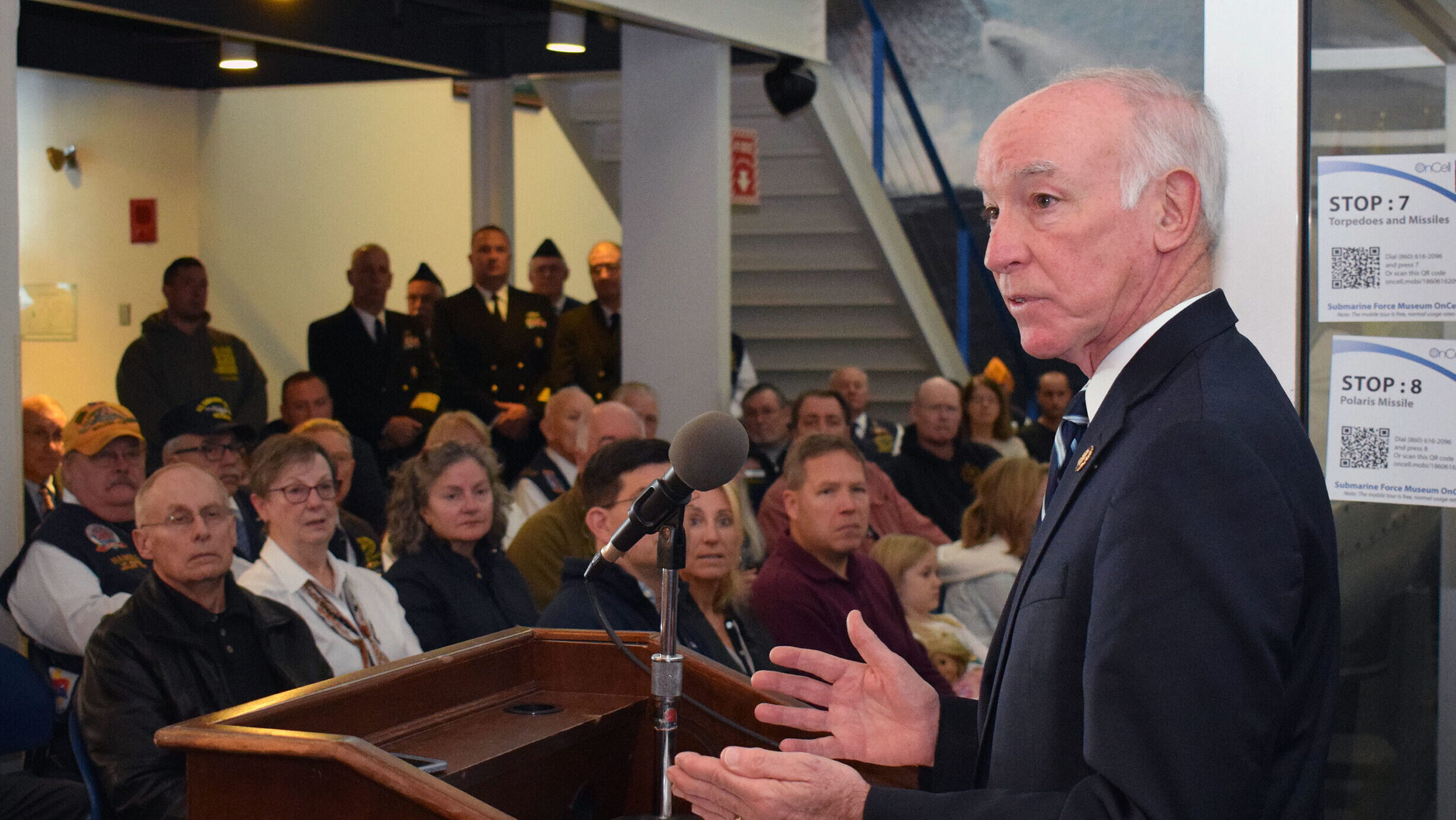
Rep. Joe Courtney, D-Conn., one of the most vocal Navy advocates in the House, says repairing the country’s current four public shipyards needs to be job “number one, two and three.” (U.S. Navy photo by Mass Communication Specialist 3rd Class Tristan B. Lotz/Released)
Reflecting the issue’s growing importance in Congress, Reps. Rob Wittman, R-Va., and Derek Kilmer, D-Wash., launched a caucus focused on the public shipyards and the SIOP in March. Other lawmakers on the caucus’ initial roster are all Democrats and include Reps. Ed Case and Kaiali’i Kahele of Hawaii, Elaine Luria and Bobby Scott of Virginia, along with Connecticut’s Joe Courtney, New Hampshire’s Chris Pappas, and Maine’s Chellie Pingree.
Over the course of a month, Breaking Defense sought comments from or interviews with all nine lawmakers on whether the idea of a fifth shipyard is viable. Some didn’t respond to multiple requests, one deferred comment to Wittman and Kilmer and, because it is 2022, one congressperson tentatively agreed to an interview, but proceeded to cancel after contracting the coronavirus.
The only two who were willing to weigh in were Courtney and Wittman, the chairman and ranking member of the House Armed Services Seapower and Projection Forces subcommittee. They both told Breaking Defense they weren’t intimately familiar with Bartlett’s proposal, but in general, neither is interested in building another shipyard while the current four are in states of disrepair.
“I do think, as [Wittman] does, that the urgent need to modernize the existing public yards is job number one, two and three,” said Courtney. “The notion of starting a new US-funded shipyard given the requirement that we already know exists is — that’s a tall order.”
Both congressmen also expressed concern about cost overruns already happening within the SIOP, which they say is due to the Navy underestimating the cost of the work, much of which is highly specialized and requires skilled labor. Wittman also called out the 20-year-timeline the service has proposed.
“The big thing from all of this is that our public shipyards have atrophied to an alarming place,” he said. “And we don’t have 20 years in order to bring them back.”
Wittman, Courtney and other lawmakers sought to add more than $20 billion to the SIOP’s budget request to supercharge its timeline in last year’s National Defense Authorization Act. That funding failed to survive through the final negotiations between the House and Senate, but Wittman and Courtney told Breaking Defense they intend to try again this year.
While the congressmen and some analysts argue the need to expedite the SIOP’s timeline is indisputable, there is also a balance the Navy must strike. Ultimately, if a dry dock is undergoing repairs, that means it is not servicing an operational ship. This means no matter how much money Congress provides the Navy, the service will always be limited in how much it can achieve in a short period of time.
Although Courtney and Wittman’s leadership positions make them key votes for any major movements in the Navy’s budget, the House Armed Services Committee places SIOP under the purview of the readiness subcommittee, led by Reps. John Garamendi, D-Calif., and Michael Waltz, R-Fla.
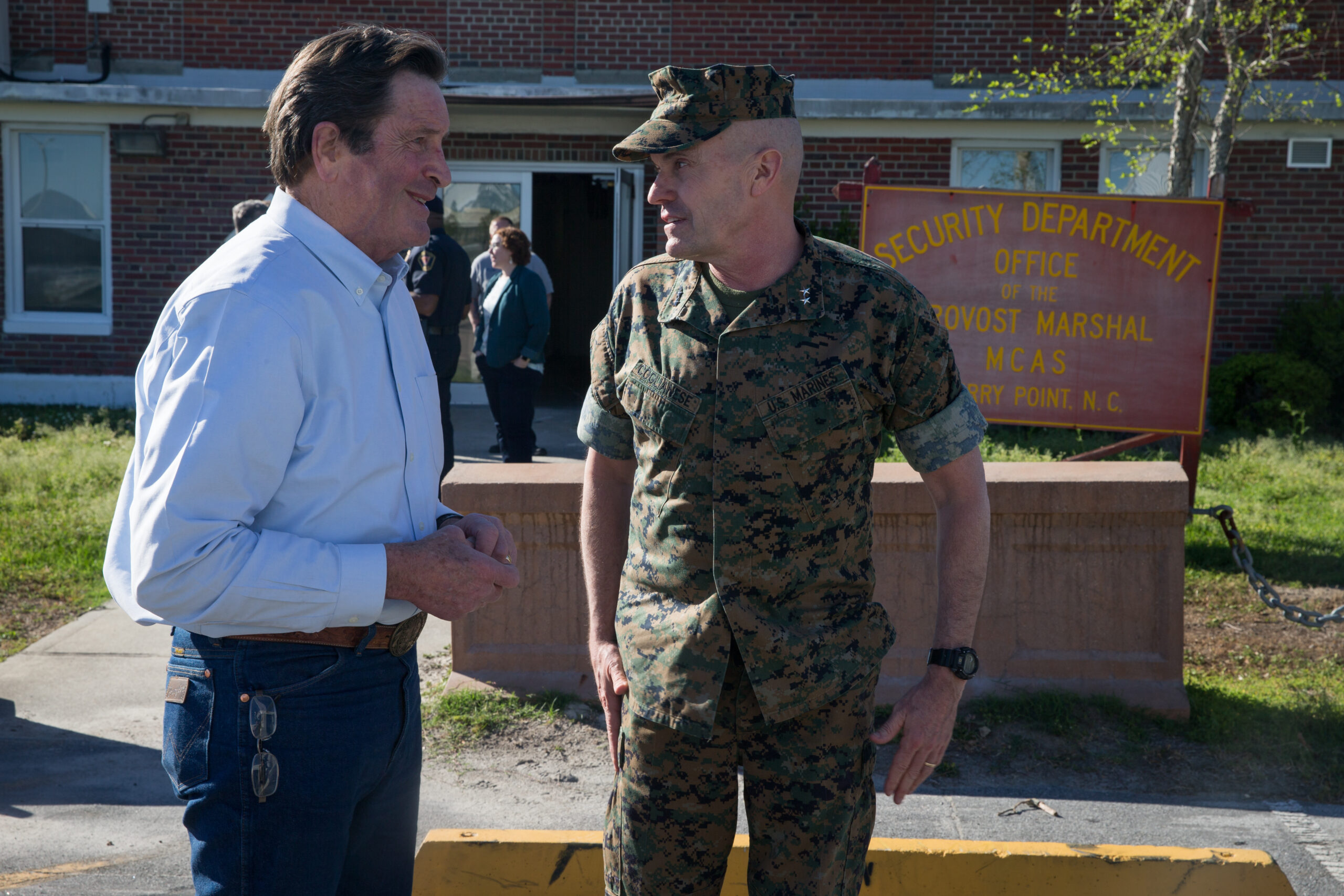
Rep. John Garamendi, D-Calif., left, meets with then-Marine Corps Maj. Gen. Vincent Coglianese, a senior officer who oversaw the service’s installations and logistics. (U.S. Marine Corps photo by Cpl. Micha Pierce)
Neither were included in the announcement of the SIOP caucus. Although he didn’t address the notion of a fifth public shipyard, Garamendi last year did take the Pentagon to task over how unimpressed he has been with their efforts on maintenance infrastructure.
“We’ve heard these are national treasures,” the California congressman said during a congressional hearing, referring to remarks about depots from various generals, admirals and service secretaries. “And yet, the supposed commitment to the depots is not translated into action. The organic industrial base infrastructure is chronically underfunded to the point these facilities are relics of the past.”
None of this precludes the Navy or Congress from taking action to establish a new shipyard in the future, but it does speak to lawmakers’ current temperature when it comes to existing efforts.
However, Cropsey, of the Yorktown Institute, told Breaking Defense that “a fifth yard is a good idea, [and] so is taking action consistent with what’s going on in the world today,” referencing Russia’s invasion of Ukraine.
And if members of Congress want a blueprint for how to proceed, there is a man in Ohio more than ready to deliver one. In fact, he’s been trying for years.
A Man, A Plan, A Shipyard: A Long-Shot
To be clear, the Navy wasn’t looking for a new shipyard when Bartlett, founder and CEO of Bartlett Maritime Corporation, sent them his unsolicited plan, twice. The company, according to Bartlett’s LinkedIn, was formed primarily to drive his shipyard proposal to the Navy. But Bartlett does have the backing of some naval heavy hitters.
The company’s advisory board includes retired Adm. Frank Bowman, a former director of Naval Reactors, the officer responsible for leading the service’s nuclear propulsion program. That job is a highly esteemed billet in the Navy which only a handful of four-star officers have held since its inception in the 1940s. The significance of being backed by a retired admiral who was responsible for the Navy’s nuclear fleet cannot be overstated. Dario Deste, the head of the Fincantieri Marine Group, which owns Fincantieri Marinette Marine, also announced his company’s support for the plan when it was touted at a Washington, DC, press conference in March.
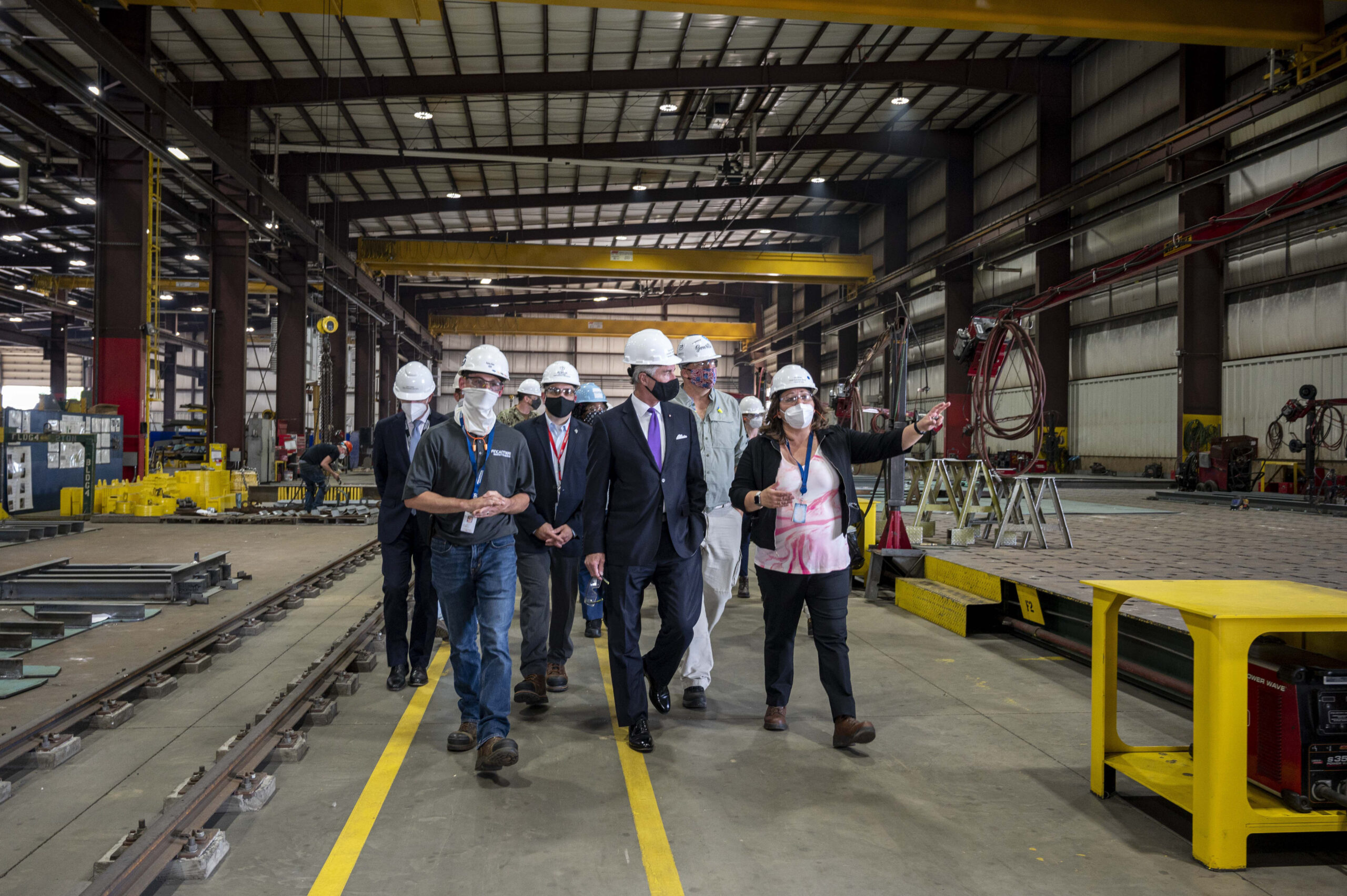
Then-Navy Secretary Kenneth Braithewaite tours Fincantieri Marinette Marine. The company has joined Bartlett’s team to build the special barge needed to transit submarines from the Atlantic Ocean to the Great Lakes. (U.S. Navy photo by Mass Communication Specialist 2nd Class Alexander C. Kubitza/Released)
Bartlett himself, in addition to 14 years in the Navy, has worked on the Seawolf and Virginia-class submarines while employed as an engineer at the Navy’s powerhouse sub builder General Dynamics Electric Boat. Bartlett, and those around him, say that he has been credited with two major breakthroughs related to submarine technology, but the exact details of those developments are classified.
His new shipyard plan is ambitious. It would involve constructing a depot facility in Lordstown, Ohio, southeast of Cleveland, and a shipyard about 80 miles northwest of Lordstown in Lorain, which sits along Lake Erie. The depot would do equipment maintenance for submarines and aircraft carriers while the Lorain-based shipyard would focus mostly on submarine maintenance.
Bartlett has a detailed two-pronged financial theory for how he would build — and the Navy would eventually own — those facilities, which he explained during an interview with Breaking Defense.
The plan itself relies on using a variety of state and federal laws and programs working in conjunction with one another. The core idea is to fund the initial construction through an Ohio state bond program while the Navy leases, and subsequently purchases, both facilities over a 30-year timeline. Bartlett’s company would act as a middleman of sorts, able to accept, shepherd and retire the state government’s bonds while simultaneously selling the facilities to the Navy through a lease-purchase agreement. He did not disclose an exact price tag for the project, except to say it is a “multi-billion dollar investment.”
Bartlett claims his plan is “budget neutral,” essentially meaning it takes steps to ensure its costs are covered by savings generated over the program’s life. In theory, that is a net positive, but in practice, as is demonstrated with the Navy low-balling its cost estimates for SIOP, the Pentagon’s budget plans often go astray for any number of reasons.
His choice for building the facilities in Ohio, as opposed to a state along the East or West Coasts, is driven by labor shortages.
“If you live on the ocean coasts, you have the aptitude, the interest and can pass a security check, [then] you’re already working in the shipyards. There’s really no ready labor pool,” Bartlett said during a March 9 press conference in Washington, DC. Due to numerous factory closures in the greater Midwest, there is “an abundance of available people that are either under employed or unemployed.”
During the March press conference, Bartlett was flanked by a panel of local Ohio government and AFL-CIO officials, defense and banking industry executives and former Navy admirals.
The press conference drew headlines and the proposal itself has won predictable support from the Ohio congressional delegation. Sen. Sherrod Brown and Reps. Tim Ryan and Marcy Kaptur, all Democrats, attended another event last week in support of the project.
However, the press conference — and much of the media coverage about Bartlett’s idea — has lacked a key voice: the US Navy.
Lack of Support, Complex Technical Concerns
The Navy has repeatedly declined over the course of six months to make the officer in charge of SIOP, Rear Adm. Troy McClelland, available for an interview. (McClelland is the same officer who will testify this week to a Senate panel.) However, there’s little indication publicly the service is giving much consideration to the idea of a new public shipyard, separate from Bartlett’s proposal.
The Navy in an April statement confirmed to Breaking Defense that it rejected Bartlett’s original proposal in 2020 due to cost and technical issues as well as specific regulations in the Pentagon’s acquisition policies. Bartlett resubmitted an updated proposal earlier this year, and, according to a Navy spokesman, the revisions did not fully correct the service’s initial concerns.
There are several technical and legal issues associated with establishing a nuclear submarine-focused public shipyard in the Great Lakes.
The first has to do with the dimensions of the St. Lawrence Seaway relative to the size of the Navy’s future subs, according to Craig Hooper, a former Austal USA executive, who wrote about Bartlett’s plan in Forbes.
The St. Lawrence Seaway connects the Great Lakes to the Atlantic Ocean and was jointly built in the 1950s by the United States and Canada. Put simply, the Navy’s future nuclear submarines sit too low in the water to traverse certain parts of the seaway. To fix this, Bartlett’s company proposes building a separate auxiliary vessel that would help the submarines maintain enough buoyancy.
“This proposed solution looks neat to the untutored eye, but it presents a set of daunting technical and operational risks,” Hooper wrote. The vessels Bartlett cites as templates for this special auxiliary ship “are both unable to transit the seaway… They won’t fit.”
As Hooper notes, the Navy would likely want to study this new vessel further before committing to it, and, as Breaking Defense has previously reported, auxiliary ships often don’t get the attention or funding they might deserve.
The Littoral Combat Ships made by Fincantieri Marinette Marine in Wisconsin regularly transit the St. Lawrence Seaway and are known to occasionally scrape the canal’s walls. That damage is mostly cosmetic, but the hull of a submarine has special coatings that, if damaged, could be much more problematic to repair. For his part, Bartlett, who has personally sailed the seaway, insists his company has done its due diligence and designed an auxiliary ship that considers these issues. Fincantieri, who are very familiar with the seaway given their yard in Wisconsin, have offered to build Bartlett’s new vessel.

Freedom-class littoral combat ships often scrape the canal walls in the St. Lawrence Seaway, but that damage is just cosmetic. (Photo courtesy of the US Navy)
But then there are the legal issues. The St. Lawrence Seaway runs through Canadian territory and the proposition of moving a nuclear submarine through it is “unprecedented,” according to Hooper, likely requiring serious diplomatic capital to be exchanged between Washington and Ottawa.
The details and laws governing transits of radioactive materials, such as the reactor that propels a nuclear sub, are complicated, to say the least. But the bottom line is that there are multiple grounds on which the Canadians could object, such as risks to the environment.
“Canada’s concerns about the viability of the submarine transit raise additional risk, and they, along with the technical questions about the barge design itself need to be worked through before proceeding,” Hooper wrote. “For a project this far along, it is somewhat stunning that they have, to date, not been explored in any detail.”
During the interview with Breaking Defense, Bartlett said his company has retained a Canadian law firm to work with the Pentagon, US State Department and the commission overseeing the international seaway in the event the Navy moves forward with his proposal. He also disputed the notion that the submarine would be carrying “radioactive cargo,” and stated that the boat remains an “independent vessel” even while sailing with assistance from a barge. It is not clear the extent to which that difference would allay Canadian concerns.
‘This Is Not A Standalone Issue’
When asked how the Navy should pitch Congress on the idea of a fifth shipyard, Bartlett said the status quo is not sustainable.
“You cannot get the fleet that you have fully maintained [and] keep them operational with the shipyards that you’ve got. It just can’t happen. They don’t have enough dry docks. They don’t have enough industrial capacity. They don’t have enough repair capacity,” he said.
On that, at least, Bartlett, the Congress and the Navy seem to be in alignment. Regardless of whether the Navy and Congress chooses to bolster the SIOP, reconsider Bartlett’s plan or seek a fifth shipyard elsewhere, the urgency to resolve the service’s maintenance backlog is only growing by the day.
The necessity to confront the capacity shortage is being highlighted by Russia’s actions in Ukraine as well as growing anxiety in the Pentagon that China will launch an offensive against Taiwan on a timeline much quicker than the US is prepared to confront.
“This is a problem that is not isolated to the shipyard plan. This pretty much extends to everything,” said Cropsey, the analyst from the Yorktown Institute. “The 30-year shipbuilding plan. The decrease that the Navy is facing in the size of its fleet … The length of time that it would take to build submarines to make good” on the AUKUS agreement with the Australia.
“This is not a standalone issue,” he continued. “This is part of a larger issue. And that is that all the planning assumes that nothing happens for 20 or so years. And that’s a mistake.”
HASC adds Virginia-class sub, cuts F-35s in $849.8 billion draft defense policy bill
The bill sticks to budget caps laid out by the Fiscal Responsibility Act.











